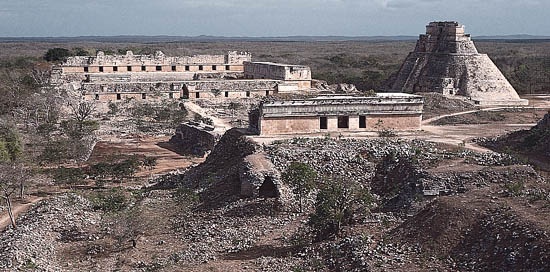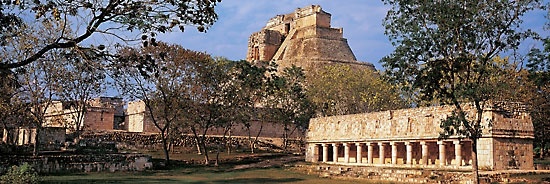Uxmal
archaeological site, Mexico
Mayan“Thrice Built”


ruined ancient Maya (pre-Columbian civilizations) city in Yucatán state, Mexico, about 90 miles (150 km) west-southwest of Chichén Itzá and 25 miles (40 km) southwest of Mayapán. By road, it is some 50 miles (80 km) south of the modern city of Mérida. Uxmal was designated a World Heritage site in 1996.
The site is the most important representative of the Puuc architectural style, which flourished in the Late Classic Period (AD 600–900). Characteristics of the Puuc style include limestone construction, often with smooth wall surfaces; plaster (stucco) finishes; masks and other representations of the rain god Chac (Chaac) (Chac); and the prevalence of styling along horizontal lines. Quite probably this style and the northern Maya lowland culture continued in full vigour for a century or so after the decline and abandonment of the southern Maya lowland centres such as Tikal, Palenque, and Uaxactún. After about 1000, when Toltec (or Toltec-inspired) invaders arrived in Yucatán and established their capital at Chichén Itzá, major construction in the city ceased. According to Maya hieroglyphic records (Mayan hieroglyphic writing), however, Uxmal continued to be occupied and was a participant in the political League of Mayapán. When the league ended, Uxmal, like the other great cities of the north, was abandoned (c. 1450). Before abandonment, the ruling family of the city, like the Itzá of Chichén or the Cocom of Mayapán, was the Tutul Xiu.
The site of Uxmal is a dry grass savanna area, but the surrounding region is heavily forested. Water was furnished by cenotes (wells formed by sinkholes in limestone understrata) within the city or by rain-collecting pools to the west. Rainfall and the supply of water were a constant preoccupation for the city's inhabitants, who frequently invoked the assistance of Chac in their architectural symbolism, hieroglyphs, and human sacrifices. Hieroglyphs reveal that an Uxmal ruler took the name “Lord Chac” about 900.
 The central ruins cover about 150 acres (60 hectares), but the remains of the residential districts extend over considerably more ground. At the tourist entrance to the central area is the Pyramid of the Magician (“Pirámide del Adivino”), which rises 90.5 feet (27.6 metres) in three concentric sections. At its base it measures about 227 by 162 feet (69 by 49 metres). The temple at the top section has a doorway in the form of a Chac mask. This pyramid is the tallest in Uxmal, but it is also known as the House of the Dwarf (“Casa del Enano”) because of an ancient legend stating that it was built overnight by an enchanted dwarf who then became the city's ruler.
The central ruins cover about 150 acres (60 hectares), but the remains of the residential districts extend over considerably more ground. At the tourist entrance to the central area is the Pyramid of the Magician (“Pirámide del Adivino”), which rises 90.5 feet (27.6 metres) in three concentric sections. At its base it measures about 227 by 162 feet (69 by 49 metres). The temple at the top section has a doorway in the form of a Chac mask. This pyramid is the tallest in Uxmal, but it is also known as the House of the Dwarf (“Casa del Enano”) because of an ancient legend stating that it was built overnight by an enchanted dwarf who then became the city's ruler. West of the Pyramid of the Magician is the Nunnery Quadrangle, consisting of four rectangular buildings with 74 individual rooms. It might have been a palace or a residence for students, priests, or soldiers. Each of the four temple-sides of the quadrangle is decorated with Chac figures. The central courtyard there measures 260 by 212 feet (79 by 65 metres). South of the quadrangle is a ball court roughly 111 by 33 feet (34 by 10 metres), called pok-ta-pok in Mayan, tlachtli in Nahua, and juego de pelota in Spanish.
West of the Pyramid of the Magician is the Nunnery Quadrangle, consisting of four rectangular buildings with 74 individual rooms. It might have been a palace or a residence for students, priests, or soldiers. Each of the four temple-sides of the quadrangle is decorated with Chac figures. The central courtyard there measures 260 by 212 feet (79 by 65 metres). South of the quadrangle is a ball court roughly 111 by 33 feet (34 by 10 metres), called pok-ta-pok in Mayan, tlachtli in Nahua, and juego de pelota in Spanish.The Governor's Palace (“Palacio del Gobernador”), standing farther south, is one of the most admired of pre-Columbian structures, and it is the finest example of the Puuc style. Its three sections stand atop a wide terrace (29 feet 【8.8 metres】 high). It is accessed by a stairway with three landings. The middle section rises to 65 feet (19.8 metres) and is joined to the two lower, flanking sections by vaulted corridors. Also on the terrace, just northwest of the Governor's Palace, is the House of Turtles, a smaller building so called from its frieze of sculptured turtles.
Just west of the Governor's Palace are the Great Pyramid, measuring 260 feet (79 metres) on each side; the House of the Pigeons, with a pigeonhole-style upper section; and the South Temple. Other notable complexes are the Cemetery Group, the House of the Old Woman (“Casa de la Vieja”), and the series of ruins called the North Group. (See also pre-Columbian civilizations: Major sites (pre-Columbian civilizations).)
- Mahayana
- Mahbubnagar
- Mahdia
- Mahdist
- mahdī
- Mahdī, al-
- Mahe
- Mahendra
- Maher, Bill
- Maheshwar
- Mahesh Yogi, Maharishi
- Mahfouz, Naguib
- Mahillon, Victor-Charles
- Mahilyow
- Mahi River
- mah-jongg
- Mahler, Alma
- Mahler, Gustav
- Mahlon Pitney
- Mahmoud
- Mahmoud Abbas
- Mahmoud Ahmadinejad
- Mahmud I
- Mahmud II
- Mahmud Muzaffar Shah